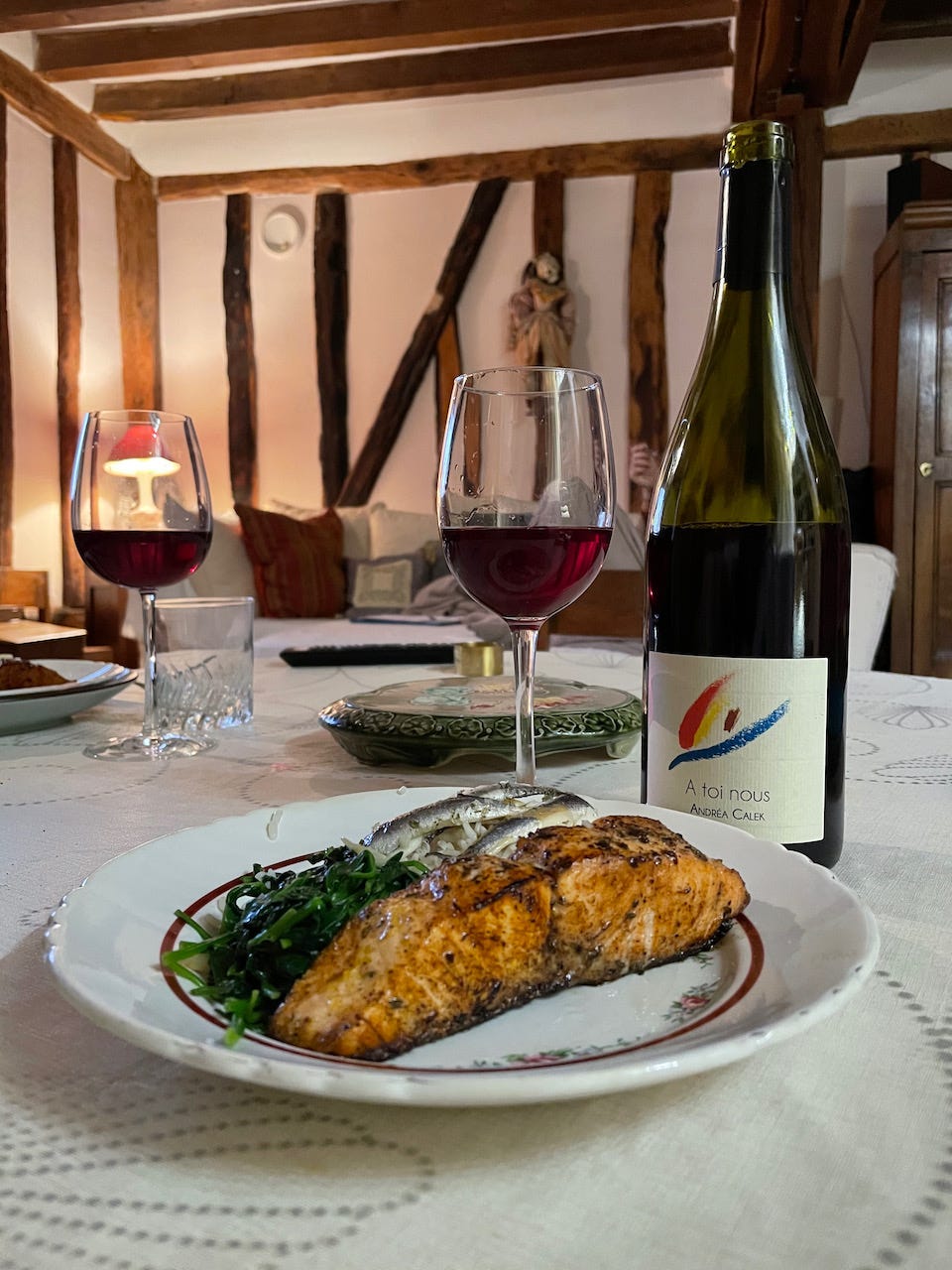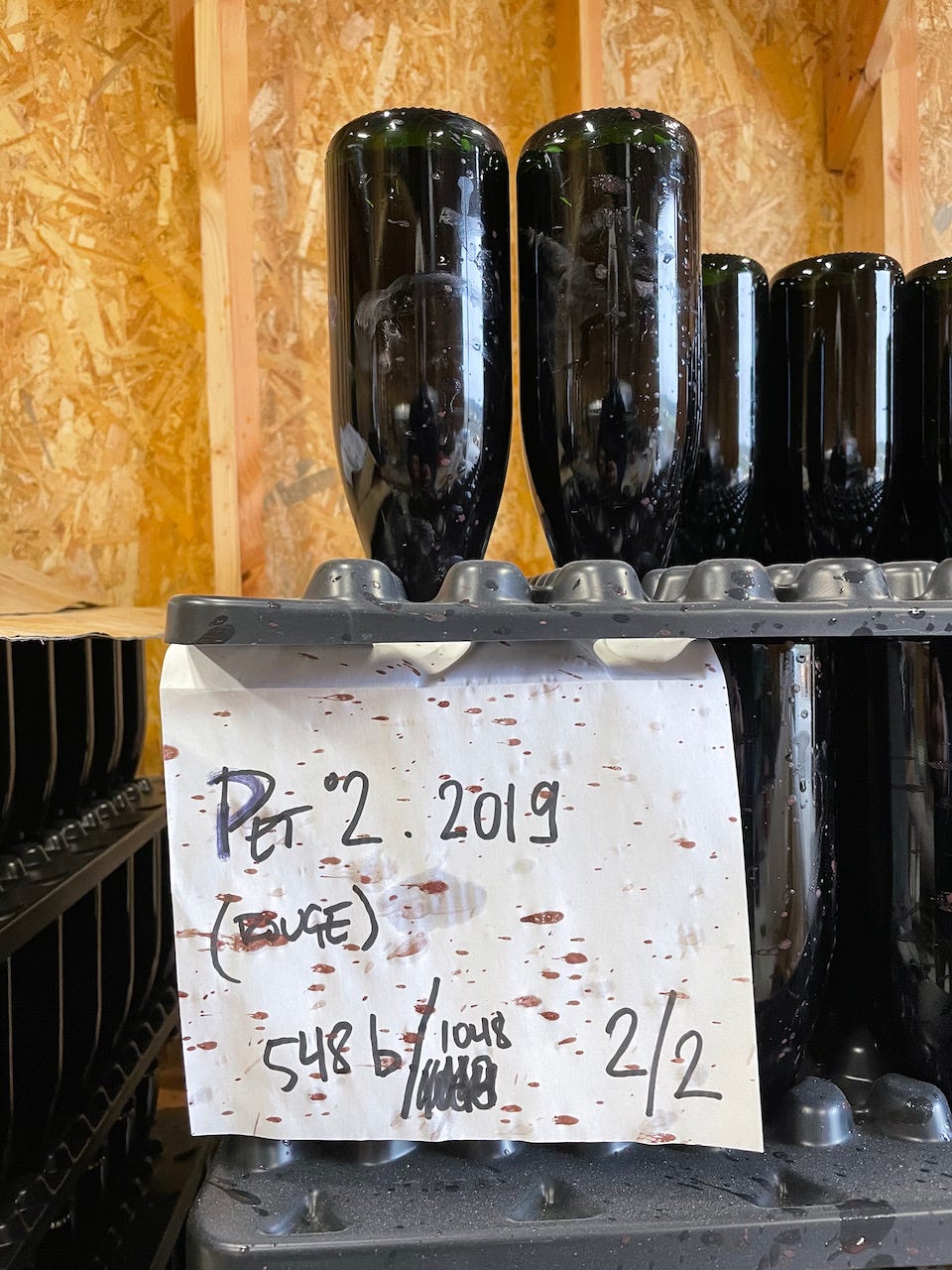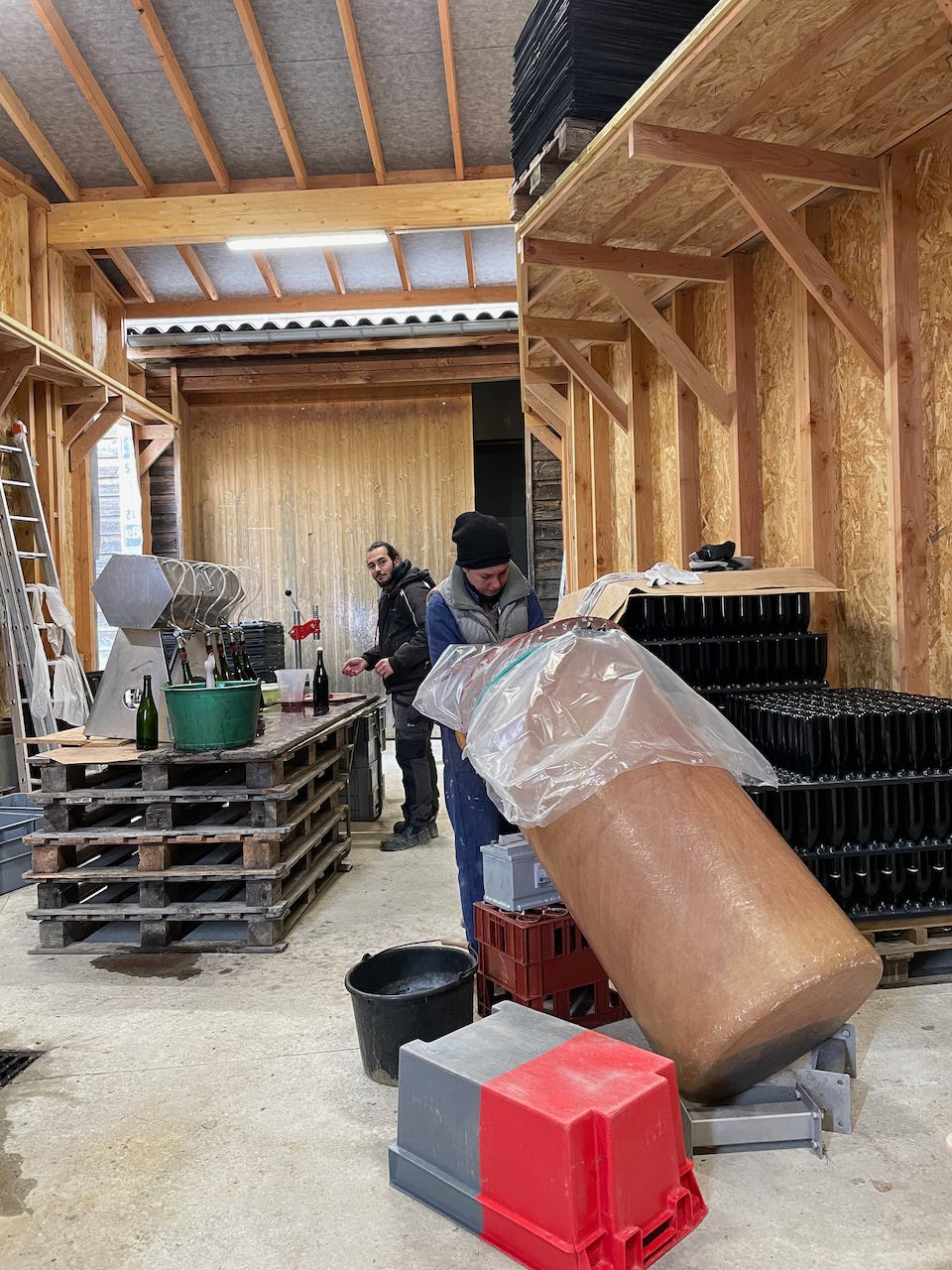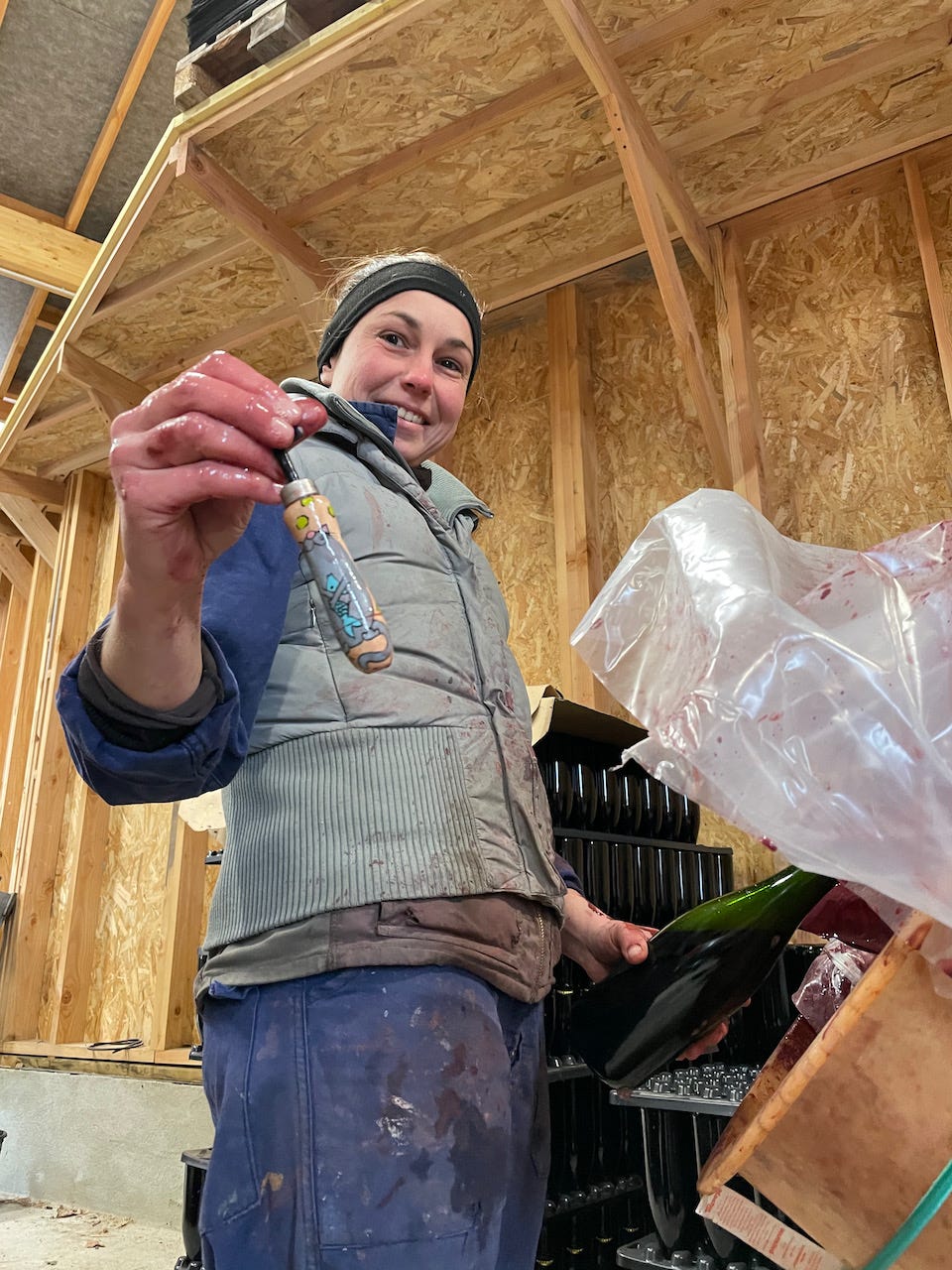Ceci N'Est Pas Un Blanc
Disgorging pétillant-naturel in Ardèche, chez Stephana Nicolescou and Andrea Calek
Czech expat Ardèche vigneron Andrea Calek and his French-American companion Stephana Nicolescou have been making experiments with pétillant-naturel for the past several years. In the course of a visit in mid-February, I joined the fun disgorging the 2019 sparkling red, entitled “Ceci N’Est Pas Un Blanc.”
“I can see why winemakers give up making pét-nats,” Stephana Nicolescou said, swirling the sparkling red wine in her glass. “It’s a lot of work.”
We were sat in the glass-walled lounge area of the handsome bioclimatic homestead she and Calek have constructed over the past few years, surrounded by the rapid winter sunset in the valley between Alba-la-Romaine and Valvignières. I remarked that the wine seemed reduced. Nicolescou explained that it had been on its lees for quite a long time. It was the 2018 or 2019, she wasn’t sure which. In fact, the couple had been producing micro-quantities of pétillant-naturels since 2018, but hadn’t gotten around to properly disgorging any of them until this year.
“We just kept putting it off,” she said, bemused. The following day, we’d disgorge, refill, and recap the 2019 red.
Back in the 2000s, Andrea Calek captured the imagination of a generation of natural wine drinkers when he famously lived like a photogenic nihilo-punk outcast in a trailer amid his vines. Things have changed since then. The couple’s wooden homestead, which became habitable in 2019, is today almost complete, lacking only a staircase to join its two floors. (Calek did the architectural plans himself, and seems to have glossed over this detail. A ladder serves the purpose for now.) Beside the homestead, built into the same hill from the same grey wood, is the winery, upon which an extension is presently being constructed, as well as a storage space-slash-harvester house which they plan, someday, to turn into a seasonal bistrot.
Even in its unfinished state, Calek’s compound is sufficiently ambitious and well thought-out as to make one suspect his anarchic reputation might be based on a fair measure of misdirection. For an outsider, he’s always been quite an insider. (For example, for many years worked on the side as an agent in Eastern Europe for the famed cooperage François Frères, a business he has since sold.) Today he seems content to let Nicolescou handle much of the day-to-day business of his winery. Quite a few years his junior, she left a job managing Paris wine bar Le Garde Robe in the early 2010s to work for vignerons in the Loire and Catalonia, before settling in Ardèche with her ex, the vigneron Samuel Bouley. (I first met Nicolescou during her time at Le Garde Robe, which was the natural wine bar closest to the central Paris office of the fashion company where I worked then. I spoke halting, pitiable French in those days. I recall being rather in awe of her facility with the culture, the language, and, of course, the vignerons.)
Nicolescou joined Calek as his estate in late 2016. By all appearances theirs is a true collaboration. She receives visitors, conducts tastings, does commercial work, prunes, debuds, racks wines, disgorges pét-nats, etc. (She’ll also release her first cuvée this year, from cabernet franc purchased from her friend the Loir-et-Cher vigneron Christophe Foucher.) Outside of harvest time, when he is laser-focused on the task at hand, Calek cooks masterful, inventive meals, reads widely, and consumes a lot of French talk radio.
The first thing to determine, when we began at 8:30AM the following morning, was how to catch the disgorged lees. Nicolescu didn’t want to simply shoot them out into the driveway, because it was too far a walk from where the rest of the refilling line was set up.
“Anders [Frederik Steen, a neighboring négoçiant-vigneron] uses a big tub full of water,” said Nicolescou, referring to the process of bath disgorgement, by which one jettisons the spent lees in the bottle neck underwater. “But I can’t deal with my hands freezing underwater all day.”
Instead she propped up a fibreglass tank at an angle, draping it with a clear plastic sheet in mostly-successful efforts to catch the backsplash. The drawback to this method is it provides only a limited zone in which to manoeuvre the bottle; one feels constrained by the limited diameter of the tank. (It’s also became hard to see through the plastic sheet, which quickly grew opaque with purple lees.)
Disgorging is a critical gesture, upon which depends the amount of wine lost with the expelled lees, as well as the clarity and quality of the finished wine. The bottles, stored upside down, must be turned right side up and opened in one fluid motion, expelling the lees before they descend and mix with the wine. Then you have to seal the bottle with thumb or forefinger, to prevent the rest of the bottle’s contents from rocketing away.
Nicolescou did over 99% of the actual disgorging. (I did perhaps eighteen bottles out of five-hundred, when she had to make a phone call.) We were aided by a local youth called Tommy. He and I took turns a) topping up the disgorged bottles by connecting them to a six-spout bottler, attached to a basin into which we periodically emptied other disgorged bottles, b) capping the bottles with a manual lever device, and c) washing and drying and stacking the finished bottles.
It took us until about 2:30pm to do a pallet. It quickly became clear that the chief bottleneck, as it were, in our working method was the six-spout bottler, which had only five working spouts, and which refilled the attached disgorged bottles with a slowness in proportion to the pressure of their contents. Working faster than it could refill the bottles, as we spent much of the morning doing, resulted only in more lost wine.
I was reminded of the Lydia Davis story, “The Race of the Patient Motorcyclists,” in which Davis describes a race in which the prize goes to the racer who manages to resist motoring off towards the horizon. Several factors made it difficult for us to work slowly, namely the cold, Nicolescou’s freezing, lees-covered fingers (which discouraged her from taking breaks from disgorgement to engage in tasks that required cleaner hands), and our own, no-less-freezing hands, drenched in wine and water from the basins we used to wash the bottles. For the first two hours, in particular, I felt like my fingers were going to fall off.
That evening over dinner (a marvelous pintade stew with firm squares of Czech pasta that a friend of Andrea’s had brought him) I happened to mention my newly-augmented admiration for someone like Manu Lassaigne of Champagne Jacques Lassaigne, for whom it is a point of pride to hand-disgorge every bottle. Lassaigne somehow manages to disgorge his Champagne without losing a drop. How does he do it? I wondered aloud.
Calek said the processes are nothing alike, insisting that Champagne fermentation is so finely calibrated that the final pressure permits a more controlled hand-disgorgement. “Whereas we have no control over what’s in there,” he said.
Initially I found this perplexing, since it seems common knowledge that Champagnes possess greater pressure than pétillant-naturels. But later it occurred to me that it really depends on the pétillant-naturel. Many vignerons specializing in this sort of wine engage in repeated clarifications of the fermenting must, through some combination of chilling, racking, and even light filtration, in efforts to ensure a less tumultuous fermentation in bottle. Calek and Nicolescou’s pét-nat is sort of a wild child, in this regard: they simply drew off some fermenting juice destined for “A Toi Nous” or “Babiole” and bottled it early. (The anarchic reputation is, after all, not purely misdirection.)
By way of postscript, I can also report that the couples’ 2020 “A Toi Nous” is truly sublime at the moment. For me it’s the first time the profile of the wine has recalled Calek’s early 2000s experiences in the Beaujolais with his friend Guy Breton: it possesses a luminescent, aerial red fruit that would make the latter proud. Yet “A Toi Nous” is born of a wholly different method: it’s a tank-aged, unsulfited blend of syrah, grenache, and carignan, of which 70% was direct-pressed. The result is a masterful, full-fruited 12°Ardèche rouge with a paleness and lightness rare in the Beaujolais these days.

Andrea Calek & Stephana Nicolescou
Saint Philippe le Bas
07400 ALBA-LA-ROMAINE
FURTHER READING



